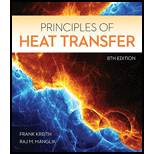
Principles of Heat Transfer (Activate Learning with these NEW titles from Engineering!)
8th Edition
ISBN: 9781305387102
Author: Kreith, Frank; Manglik, Raj M.
Publisher: Cengage Learning
expand_more
expand_more
format_list_bulleted
Expert Solution & Answer
Want to see the full answer?
Check out a sample textbook solution
Students have asked these similar questions
please help solve
please help solve
Two springs and two masses are attached in a straight vertical line as shown in Figure Q3. The system is set
in motion by holding the mass m₂ at its equilibrium position and pushing the mass m₁ downwards of its
equilibrium position a distance 2 m and then releasing both masses. if m₁ = m₂ = 1 kg, k₁ = 3 N/m and
k₂ = 2 N/m.
www.m
k₁ = 3
(y₁ = 0).
m₁ = 1
k2=2
(y₂ = 0)
|m₂ = 1
Y2
y 2
System in
static
equilibrium
(Net change in
spring length
=32-31)
System in
motion
Figure Q3 - Coupled mass-spring system
Determine the equations of motion y₁(t) and y₂(t) for the two masses m₁ and m₂ respectively:
Analytically (hand calculations)
Chapter 7 Solutions
Principles of Heat Transfer (Activate Learning with these NEW titles from Engineering!)
Knowledge Booster
Learn more about
Need a deep-dive on the concept behind this application? Look no further. Learn more about this topic, mechanical-engineering and related others by exploring similar questions and additional content below.Similar questions
- Two large tanks, each holding 100 L of liquid, are interconnected by pipes, with the liquid flowing from tank A into tank B at a rate of 3 L/min and from B into A at a rate of 1 L/min (see Figure Q1). The liquid inside each tank is kept well stirred. A brine solution with a concentration of 0.2 kg/L of salt flows into tank A at a rate of 6 L/min. The diluted solution flows out of the system from tank A at 4 L/min and from tank B at 2 L/min. If, initially, tank A contains pure water and tank B contains 20 kg of salt. A 6 L/min 0.2 kg/L x(t) 100 L 4 L/min x(0) = 0 kg 3 L/min B y(t) 100 L y(0) = 20 kg 2 L/min 1 L/min Figure Q1 - Mixing problem for interconnected tanks Determine the mass of salt in each tank at time t > 0: Analytically (hand calculations)arrow_forwardplease help solvearrow_forwardplease help solvearrow_forward
- please help solvearrow_forwardplease help solvearrow_forwardA steam pipe is covered with two layers of insulation. The inner layer (k = 0.17 W/m-K) is 30 mm thick and outer layer (k = 0.023 W/m-K) is 50 mm thick. The pipe is made of steel (k = 58 W/m-K) and has inner diameter and outer diameter of 160 and 170 mm, respectively. The temperature of saturated steam is 300 °C and the ambient air is at 50 °C. If the inside and outside heat transfer coefficients are 30 W/m²K and 5.8 W/m²-K respectively, calculate the rate of heat loss per unit length of the pipe.arrow_forward
- An aluminium pipe carries steam at 110 °C. The pipe (k 185 W/m °C) has an inner diameter of 100 mm and an outer diameter of 120 mm. the pipe is located in a room where the ambient air temperature is 30 °C and the convective heat transfer coefficient between the pipe and air is 15 W/m2°C. .2.1) Neglecting the convective resistance of the steam, determine the heat transfer rate per unit length of pipe. hs o 1101 2.2) To reduce the heat loss from the pipe, it is covered with a 50 mm thick layer of insulation (k 0.20 W/m C). Determine the heat transfer rate per unit length from the insulated pipe. Assume negligible convective resistance from the steamarrow_forward問題1 Facilities planning activities include... product design facility layout design process design all of the abovearrow_forward16.1. The cart has mass M and is filled with water that has a mass mo. If a pump ejects water through a nozzle having a cross-sectional area A at a constant rate of vo relative to the cart, determine the velocity of the cart as a function of time. What is the maximum speed developed by the cart assuming all the water can be pumped out? Assume the frictional resistance to forward motion is F and the density of water is p.arrow_forward
- 16.2 A block of mass 10 kg is subjected to a force F(t) at an angle 30° from the horizontal that is at a constant 12 N for 3 seconds and is suddenly increased to 18 N afterwards. A constant 1 N force acts on the block as shown as well. The static and kinetic friction coefficients between the block and the ground is 0.15 and 0.10, respectively. Determine the magnitude and direction of the velocity of the block after 5 seconds. Ms=0.15 Mk = 0.10 F(t) [N] F(t) 18 1 N 30° m = 10 kg 12 t [s] 3arrow_forwardNo chatgptarrow_forwardplease help me solve this equationarrow_forward
arrow_back_ios
SEE MORE QUESTIONS
arrow_forward_ios
Recommended textbooks for you
 Principles of Heat Transfer (Activate Learning wi...Mechanical EngineeringISBN:9781305387102Author:Kreith, Frank; Manglik, Raj M.Publisher:Cengage Learning
Principles of Heat Transfer (Activate Learning wi...Mechanical EngineeringISBN:9781305387102Author:Kreith, Frank; Manglik, Raj M.Publisher:Cengage Learning

Principles of Heat Transfer (Activate Learning wi...
Mechanical Engineering
ISBN:9781305387102
Author:Kreith, Frank; Manglik, Raj M.
Publisher:Cengage Learning
Heat Transfer – Conduction, Convection and Radiation; Author: NG Science;https://www.youtube.com/watch?v=Me60Ti0E_rY;License: Standard youtube license